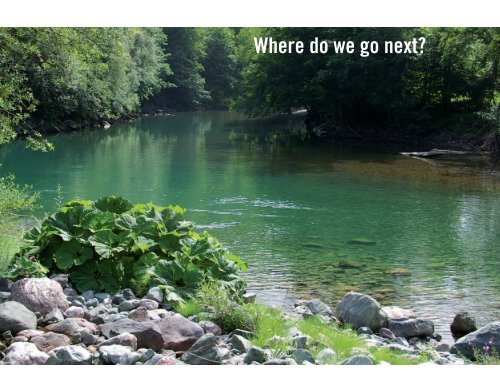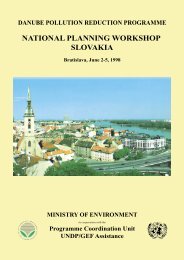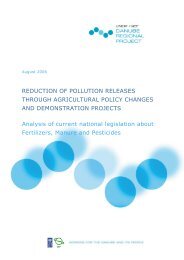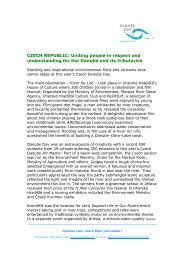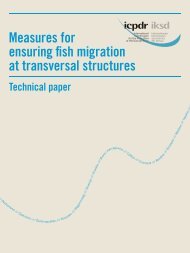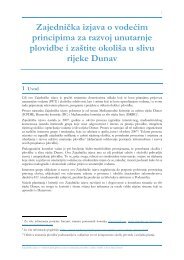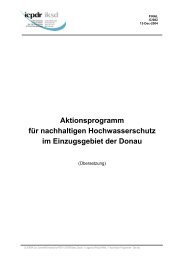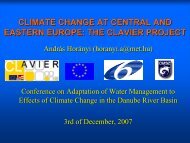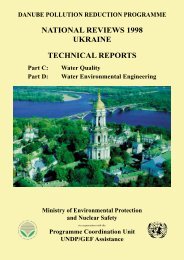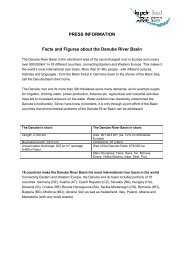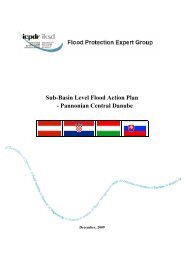The Danube River Basin Management Plan 2009-2015 - ICPDR
The Danube River Basin Management Plan 2009-2015 - ICPDR
The Danube River Basin Management Plan 2009-2015 - ICPDR
You also want an ePaper? Increase the reach of your titles
YUMPU automatically turns print PDFs into web optimized ePapers that Google loves.
Where do we go next?<br />
Work is ongoing to understand the complex nature of the <strong>Danube</strong> <strong>Basin</strong>. <strong>The</strong> impact of<br />
measures at the basin-wide scale is not yet directly linked to the status assessment of individual<br />
water bodies; follow-up work will investigate this further. Additional studies on<br />
sediments, invasive species, water quantity issues and the impacts of climate change are<br />
also crucial, as are further improvements in the overall monitoring process. As regards<br />
the WFD timetable, the next stage is the introduction of pricing policies, ensuring the true<br />
cost of water use is calculated. 2012 is the deadline for implementing the Joint Programme of<br />
Measures, followed in <strong>2015</strong> by the deadline for achieving good status in all water bodies.<br />
“<strong>The</strong> work on the <strong>Danube</strong> <strong>River</strong> <strong>Basin</strong> <strong>Management</strong> <strong>Plan</strong> has produced a plan we can all<br />
be proud of. Now is the time to put our plan into action!”<br />
Philip Weller, Executive Secretary of the <strong>ICPDR</strong><br />
<strong>The</strong> further development of this DRBM <strong>Plan</strong> and its implementation will guide developments<br />
in the basin over the next two decades and beyond. Putting the <strong>Plan</strong> into action is a<br />
challenge for everyone involved in managing or using the waters of the <strong>Danube</strong> <strong>Basin</strong>. For national<br />
and local governments, the <strong>Plan</strong> needs to percolate into every section of decision-making<br />
across all sectors. Public participation will continue to be at the forefront of the work at<br />
the national and basin-wide level – this is essential for us to move towards the <strong>Danube</strong><br />
visions. At the regional, national and local level, public bodies, land and water managers,<br />
businesses, voluntary bodies and the general public will need to cooperate closely.<br />
Sometimes working together will provide easy win-win solutions that directly benefit all<br />
immediately. Other times, difficult decisions will have to be made, water users will<br />
need to compromise and relinquish some specific objectives in order for the proposed<br />
measures to be transformed into enhancements on the ground. But the overall result will<br />
be an improved living and working environment for all.<br />
For centuries, the people of the <strong>Danube</strong> countries have relied on the resources of the river<br />
and its tributaries. Today this dependence is as strong as ever, with the rivers providing<br />
domestic drinking water, industrial and agricultural water supply, sewage discharge,<br />
hydroelectric power generation, navigation, tourism, recreation and fisheries. <strong>The</strong> <strong>Danube</strong><br />
environment is a unique habitat, home to globally important plants and animals. With<br />
your involvement, together we can ensure that the <strong>Danube</strong> rivers continue to support<br />
people and ecosystems for the centuries ahead.<br />
19


